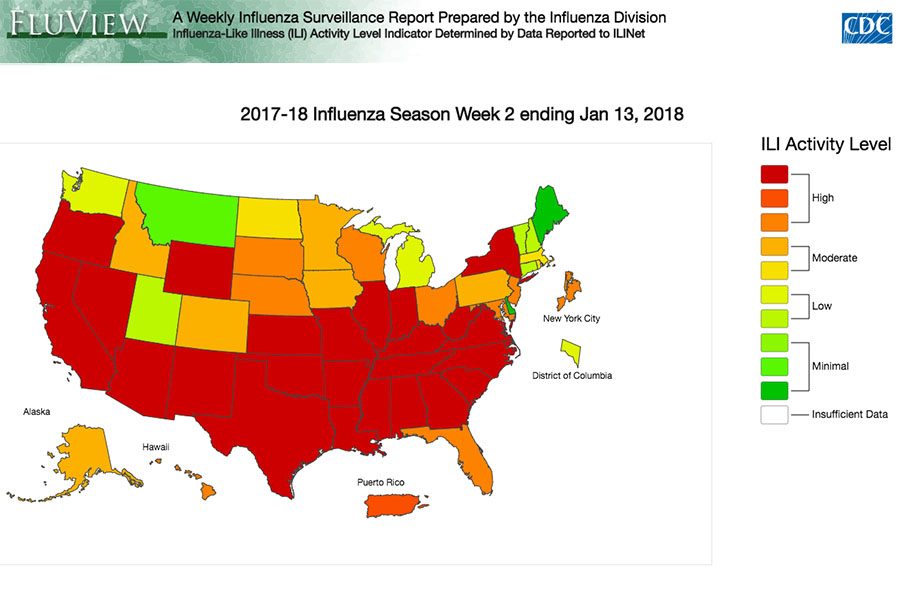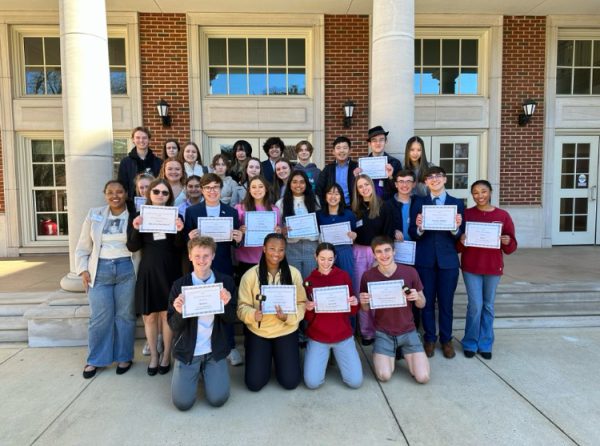Deadly Flu Sweeps Nation
January 24, 2018
This winter, influenza has been spreading. Cases have been reported in all 50 states, with widespread infection in 50 of the 54 states and territories. 30 flu-related deaths have been reported since Oct. 1. The last year that the United States had a major flu pandemic like this was in 2009, with the outbreak of the H1-N1 strain.
This year, the H1-N1 strain is still active, but A(H3N2) is the virus to watch for. Most flu cases in the world test positive for this strain. The H3N2 strain is associated with higher rates of hospitalization and death among the young and the elderly. The current flu vaccine is less effective against the H3N2 strain. However, antiviral drugs commonly prescribed for the seasonal flu are still effective against H3N2.
Closer to home, two deaths garnered attention. A third grader at Pike Road Elementary School died Tuesday, Jan. 16 in the hospital. She was taken to the hospital after staying home from school with a fever that kept rising. The week before, University of Alabama professor John McDuffie contracted the flu and died at home.
These, among other deaths and the large number of people heading to hospitals, prompted state health officials and Governor Kay Ivey to issue a state public health emergency.
Local hospitals are valiantly meeting the increased demand on their resources. “We are handling it to the best of our capabilities. We’re encouraging patients with […] flu-like symptoms to wear masks while in the medical center. We have hand sanitization stations throughout the hospital; we’ve also got flu swabs on all doctors and we use them on anyone with flu-like symptoms, as well as heavily encouraging anyone who exhibits flu-like symptoms to get tested. We are also spraying down equipment and doors as much as possible to prevent the virus from spreading,” said Erin Shaver, a nurse at Crestwood Medical Center.
It’s also a struggle, as “the flu vaccine is showing 10% effectiveness on Flu A and 40% on flu B,” said Shaver.
The CDC says that “antibodies made in response to vaccination with one flu virus can sometimes provide protection against different but related flu viruses. A less than ideal match may result in reduced vaccine effectiveness against the flu virus that is different from what is in the flu vaccine, but it can still provide some protection against flu illness. In addition, it’s important to remember that the flu vaccine contains three or four flu viruses (depending on the type of vaccine you receive) so that even when there is a less than ideal match or lower effectiveness against one virus, the flu vaccine may protect against the other flu viruses.” The website went on to say that “while all influenza viruses undergo frequent genetic changes, the changes that have occurred in influenza A(H3N2) viruses have more frequently resulted in differences between the virus components of the flu vaccine and circulating influenza viruses (i.e., antigenic change) compared with influenza A(H1N1) and influenza B viruses. That means that between the time when the composition of the flu vaccine is recommended and the flu vaccine is delivered, H3N2 viruses are more likely than H1N1 or influenza B viruses to have changed in ways that could impact how well the flu vaccine works.”
“It sucked,” said Matthew Enfinger, a Bob Jones junior who had the flu last weekend. “I [got vaccinated this year] by the school. Still got it.”
With the freezing temperatures and snow, school was out for five straight days last week. This is hoped to have corralled the virus.
“The Center for Disease Control and the Alabama Department of Public Health are reporting widespread flu activity in Alabama,” said Bonnie Davis, Madison City Schools district nurse, “Schools were thoroughly cleaned and sanitized over the break.”
“We’re doing okay at Bob Jones right now. We’ve had a few cases of the flu, but not a terrible outbreak,” school nurse Sheila Kasulka said.
However, if enough sick individuals are present, the flu virus can easily be spread to most of the student body. Davis pleaded, “Please be mindful that the best way to heal from and prevent the spread of the flu virus or other illnesses is to keep your child home if they are sick.”
Kasulka said that even if you do come to school, “the number one thing to decrease the spread of most infectious diseases is to keep your hands clean.”
Students worried about making up class and homework, as well as running out of school excuses, need to stay home. The attendance office has said it is happy to work with sick students to excuse sick days.












